The original plans at the start of the Farm Profit Programme project identified that the Mackays’ farm at Caithness was under-stocked. However, winter accommodation was a limiting factor.
“To tackle this, we have applied for planning permission for a new cattle shed. It will be similar to the bedded court that is currently there and will go alongside it,” Mark said.
“The kit is ordered and the hope is that it will be up by Christmas. This will allow us to increase cow numbers to utilise the grass that we are now growing.”
“Last summer, the improved soil fertility on the farm started to show through with the amount of silage we went in to winter with.

Mark uses mainly Simmental genetics for his suckler cows.
“Winter was not bad, and the cattle were back out to grass at a similar time as the previous year. However, this has meant that we carried forward quite a lot of silage into this year. The silage pit was around a quarter full at turnout and there were also around 500 bales.
“Grass growth this year has also been fantastic, meaning we now have a full pit and 1,315 bales of silage in the yard. Not only that, grass growth continues to be good and we are struggling to keep up with it.
Some of the cows are on a rotation behind the silage and the grass available is fantastic.
“If we can keep that level of cover into the back end, it will help to shorten the winter.
“Cow numbers have been increased a little this year, with the plan being to grow again next year to fill the shed. So far, we have identified 15 cows for culling. However, we have brought home nine bulling heifers and 23 cows with calves at foot. Once the shed is up and finished, we will go back to the market and purchase more.
“We may also retain more of our own heifers next year. While it means cashflow is reduced for the year, it does mean that we are getting genetics that we know and like. We have also purchased two aged bulls. We lost a Charolais early in the season and the Simmental was due his time.
“Generally, we would have bought younger bulls. However, to reduce cost and to ensure that they were ready to go straight to work, we decided to go for older bulls that were proven but still fit for action.
“The Simmental is currently with the summer calvers on the hill to breed us some replacements for that herd.
“Calving was fairly good this year but we did lose more cows than usual, with five not making it for a variety of causes. All have been investigated and while it is frustrating, there is little we can do about them.

A two-year-old heifer and calf at Greenvale.
“We also had seven sets of twins born this year, so we have more calves than cows. The girls have loved this as they have bottle-reared some of them.
“The improved soil fertility and subsequent grass growth has also meant that we have been able to increase the area of barley that we have. This year, there is 26 hectares in the ground, up from 20 hectares last year. Some of the barley is in fields that we are reclaiming into production to allow us to clean up the weeds before we sow them to grass. Around 3 hectares of the barley is in Prospect, a new variety to us to see how it performs. If it does well enough, we will keep some for seed.

Mark MacKay's bulling heifers.
“With the investment we have made in the business over the last four years, we now have a clear direction for the future. While we are increasing cow numbers, we are not using any more fertiliser than before on the grass. Coupling this with the increase in barley acres at home, we are getting more output from every acre of the farm. With this plan we aim to be able to ride out any change in the support regime and take the business forward for our girls.
The original plans at the start of the Farm Profit Programme project identified that the Mackays’ farm at Caithness was under-stocked. However, winter accommodation was a limiting factor.
“To tackle this, we have applied for planning permission for a new cattle shed. It will be similar to the bedded court that is currently there and will go alongside it,” Mark said.
“The kit is ordered and the hope is that it will be up by Christmas. This will allow us to increase cow numbers to utilise the grass that we are now growing.”
“Last summer, the improved soil fertility on the farm started to show through with the amount of silage we went in to winter with.

Mark uses mainly Simmental genetics for his suckler cows.
“Winter was not bad, and the cattle were back out to grass at a similar time as the previous year. However, this has meant that we carried forward quite a lot of silage into this year. The silage pit was around a quarter full at turnout and there were also around 500 bales.
“Grass growth this year has also been fantastic, meaning we now have a full pit and 1,315 bales of silage in the yard. Not only that, grass growth continues to be good and we are struggling to keep up with it.
Some of the cows are on a rotation behind the silage and the grass available is fantastic.
“If we can keep that level of cover into the back end, it will help to shorten the winter.
“Cow numbers have been increased a little this year, with the plan being to grow again next year to fill the shed. So far, we have identified 15 cows for culling. However, we have brought home nine bulling heifers and 23 cows with calves at foot. Once the shed is up and finished, we will go back to the market and purchase more.
“We may also retain more of our own heifers next year. While it means cashflow is reduced for the year, it does mean that we are getting genetics that we know and like. We have also purchased two aged bulls. We lost a Charolais early in the season and the Simmental was due his time.
“Generally, we would have bought younger bulls. However, to reduce cost and to ensure that they were ready to go straight to work, we decided to go for older bulls that were proven but still fit for action.
“The Simmental is currently with the summer calvers on the hill to breed us some replacements for that herd.
“Calving was fairly good this year but we did lose more cows than usual, with five not making it for a variety of causes. All have been investigated and while it is frustrating, there is little we can do about them.

A two-year-old heifer and calf at Greenvale.
“We also had seven sets of twins born this year, so we have more calves than cows. The girls have loved this as they have bottle-reared some of them.
“The improved soil fertility and subsequent grass growth has also meant that we have been able to increase the area of barley that we have. This year, there is 26 hectares in the ground, up from 20 hectares last year. Some of the barley is in fields that we are reclaiming into production to allow us to clean up the weeds before we sow them to grass. Around 3 hectares of the barley is in Prospect, a new variety to us to see how it performs. If it does well enough, we will keep some for seed.

Mark MacKay's bulling heifers.
“With the investment we have made in the business over the last four years, we now have a clear direction for the future. While we are increasing cow numbers, we are not using any more fertiliser than before on the grass. Coupling this with the increase in barley acres at home, we are getting more output from every acre of the farm. With this plan we aim to be able to ride out any change in the support regime and take the business forward for our girls.









 This is a subscriber-only article
This is a subscriber-only article











SHARING OPTIONS: